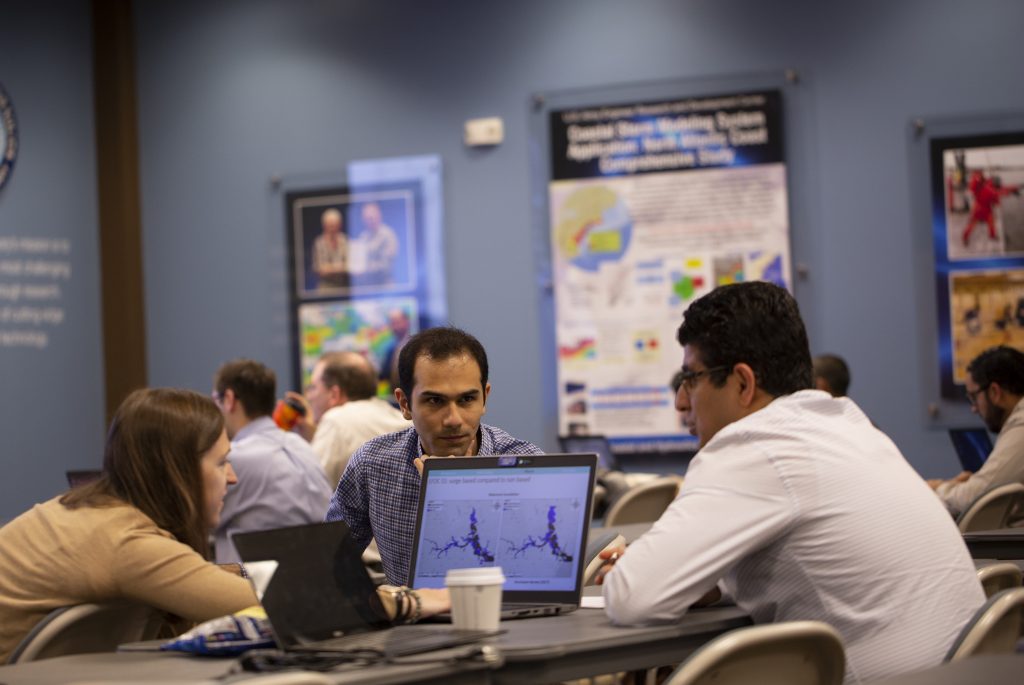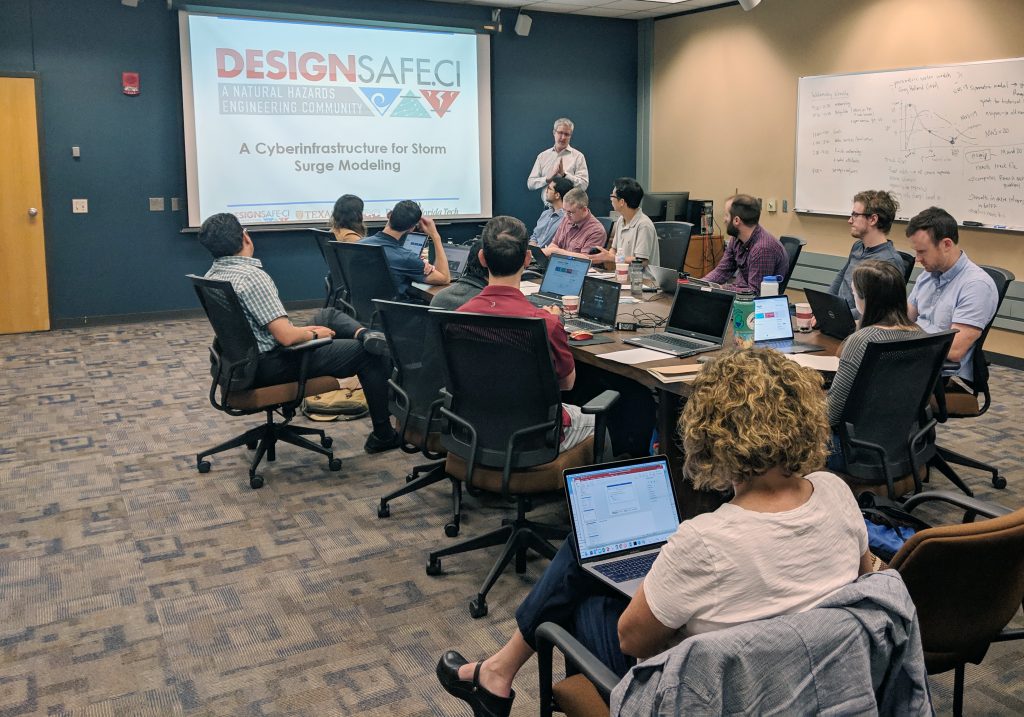
As Subtropical Storm Andrea formed in the Atlantic Ocean – 12 days before the official start of Atlantic hurricane season – a community of coastal modelers gathered to discuss the latest research and uses of the ADCIRC computer model. The model, part of the ADCIRC Prediction System™, provides decision support for hazards like storm inundation during tropical cyclones.
More than 50 people gathered at the U.S. Army Engineer Research and Development Center’s Coastal Hydraulics Lab (ERDC CHL) in Vicksburg, Miss., from May 20-21 for the 23rd ADCIRC Users Group Meeting. Federal, academic and private-sector users of the model met to discuss their work in a less formal environment that encourages discussion and partnership.
The event was co-organized by CRC PI Jason Fleming of Seahorse Consulting and Chris Massey and Mary Cialone of the ERDC CHL.
In past years, the Users Group Meeting has been held in the same week and location as the ADCIRC Boot Camp, a hands-on training event for newer users. Because of high user demand, Fleming said he broke the event into separate parts, with Boot Camp-style events being held on the University of Texas-Austin campus in March and another planned for November in Florida.
Presentations at the Users Group Meeting featured real-world applications for ADCIRC such as testing the impact of building higher sea walls in southeastern Florida on coastal water overflow during tropical storms. They also included several looks at ways to improve the speed and automating of ADCIRC-related tools.
“The ADCIRC Users Group Meeting is intense because it is our annual consensus-building process for the ADCIRC technology roadmap,” Fleming said. “Developers, researchers, consultants and professional engineers come together to exchange ideas, and we’ve seen increasing interest in translating operational experiences into the research agenda. The Meeting also supports workforce development by exposing students to emerging trends and giving employers a chance to evaluate the next generation of job candidates.”

Attendees voted on an ADCIRC Community Man and Woman of the Year, honoring involvement with the modeling community and contributions to the improvement of ADCIRC-related tools. The 2019 winners were Taylor Asher, a Ph.D. student at the University of North Carolina, and Ashley Kauppila, a Project Engineer with Taylor Engineering.
Other finalists were Louisiana State University (and CRC) researcher Matt Bilskie and Crystal Fulcher, Research Technician at UNC-Chapel Hill’s Institute of Marine Sciences.
Asher won the award for his efforts to educate newcomers to the ADCIRC community and for leading efforts to improve the web presence of ADCIRC by establishing and managing the new ADCIRC Wiki site. Kauppila was honored for her work developing new meshes (highly detailed digital representations of coastal areas) for FEMA projects and for mentoring newer users on GIS techniques for ADCIRC.
Attendees said the annual gathering is important to learn from their peers and find new avenues of research and application for the model.
“My staff and I come to learn about the latest breakthroughs with ADCIRC and where it’s going,” said Elizabeth Valenti, Presidents of Worldwinds Inc., a company that uses meteorological modeling to consult with clients. “I come to see what new opportunities may be coming up, and we’ve been doing that for over 15 years.”

Boot Camp events
A second event, Texas ADCIRC Week, was held April 8-12, 2019, at the University of Texas-Austin, and was the first of two events to be held this year in place of the traditional Boot Camp event. It was co-hosted by Gordon Wells (UT-Austin Center for Space Research), CRC researcher Clint Dawson (Institute for Computational Engineering and Sciences), and Fleming of Seahorse Consulting.
The training event brought together public- and private-sector coastal modelers to focus on improving familiarity with ADCIRC to predict tropical storms and coastal flooding, as well as emergency personnel that use model results for operational decisions. The Texas State Operations Center uses the ADCIRC Prediction System™ for decision support related to community planning and real-time rescue operations.
Thirty-eight participants attended sessions covering everything from “ADCIRC Fundamentals” to “Mapping for Risk Communication.” They came from 14 U.S. academic institutions, seven private-sector groups, three federal agencies and one international research institution.
Another ADCIRC Week event, focused on Florida, is planned for late this year.

About the ADCIRC™ Prediction System
The ADCIRC Prediction System™ (APS™) provides timely, high-resolution information on coastal storm surge, flooding and winds to emergency responders, federal, state and local leaders and the general public. APS™ uses the ADCIRC storm surge model on high-performance computers to generate storm forecast guidance and can provide end users with customized data for geographic areas of particular concern. A sophisticated web portal (Coastal Emergency Risks Assessment or CERA) has been developed to provide convenient visualizations of these results.
APS™ data have been used by multiple federal and state agencies to help predict flooding associated with storm surge. The U.S. Army Corps of Engineers, the National Oceanic and Atmospheric Administration, the U.S. Coast Guard, the Federal Emergency Management Agency and the Texas Department of Emergency Management are among the agencies that factor ADCIRC modeling into their operations. At the local level, results are shared with coastal emergency managers to assist with decision-making, including road closings, evacuations and search and rescue operations.
